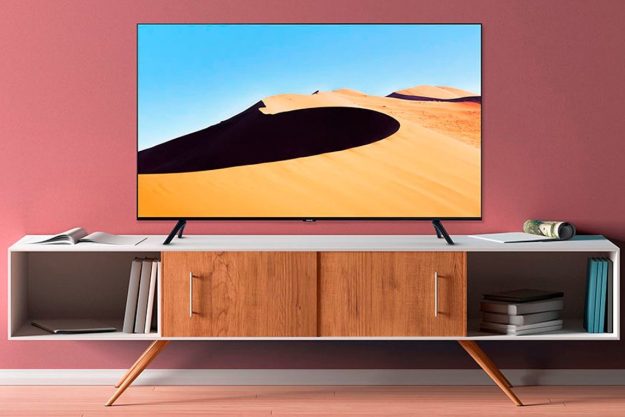
“Not only can the G-Boom stand up to rough conditions, it puts out more power, clarity, and vibrancy than a speaker in its price range has a right to.”
- Clear, full midrange
- Smooth upper register
- High max volume
- Affordable portability
- Limited battery life
- Occasional low end distortion
They say style is cyclical. It wasn’t too long ago that everyone counted the 80’s out forever. But here we sit watching jean jackets and Risky Business Ray-Bans reach the height of hipster fashion while freaking New Kids on the Block is going on tour! Even they didn’t see that one coming. So it’s not surprising that the ever expanding Bluetooth speaker market would also take up the call, reviving an old 80’s favorite, the Boombox.
Look around, and you’ll see the Boombox is making a comeback — this time with a wireless twist. One such example of the neo-vogue device is G-Project’s G-BOOM. The tough, all-black speaker box is made by some of the same folks that designed the Sound Platform 2, and promises big sound in a portable package for only $100. With attractive 21st century additions like Bluetooth connection, rechargeable batteries, and DSP sound, maybe this is the time for a Boombox revival.
We recently sat down with the G-BOOM to see what kind of sound you can get from a $100 Bluetooth Boombox – and maybe play some “Rappers Delight” at shoulder level. Here’s what happened.
Out of the box
Pulling the G-BOOM from its bright yellow box revealed a fairly hefty trapezoid of rough-and-tumble speaker, its black exterior layered in corrugated plastic and thick rubber. Looking more like an oversized lunch pail than a Boombox, the G-BOOM is solidly constructed and built for travel, with rubberized control keys, and heavy metal rods supporting the handle and side ports. Inside the package we found a DC power adaptor and a 3.5mm aux cable.
Features and design
The G-BOOM cuts a fairly formidable presence, evoking an aesthetic somewhere between a Batman weapon and a robotic briefcase. The speaker is a bit rough to the touch, covered in sharp angles of heavy plastic and metal. The rugged handle arches above a top panel of soft rubber – a welcome addition, as the hand tends to rub against the underside during transport. Set into the panel is a row of rubberized keys which control power, Bluetooth pairing, EQ, volume, song search, and play.
Set across the front face of the device is a large metal speaker screen with wobbly ripples carved into it, as if perpetually blasted by physics-bending sound. Beneath the screen sit the G-BOOM’s dual speaker sets, including a pair of 1-inch tweets set above a pair of 3-inch midrange drivers. On the reverse side are two sound ports which help to reinforce bass. Beneath the ports is a rubber flap which protects the DC power input, a USB port for charging devices, and a 3.5mm line input.

At the base of the front speaker screen is a trapezoid-shaped display window housing 3 LEDs which illuminate white, blue, and red, for power, pairing, and charging respectively. With two rather chintzy clicks of the control keys we had the speaker fired up and pairing, almost instantly appearing in our device settings as “G-BOOM”.
The G-BOOM offers a decent feature set for an entry level speaker, including the aforementioned ability to charge mobile devices, a lithium ion battery with an approximated 6 hour run time, and an EQ with three stock presets including flat, rock, and pop. For most of our listening, we used the rock setting which seemed to have a fuller, more bass-oriented sound.
At the bottom-rung price of $100, we weren’t surprised to find the G-BOOM uses the older Bluetooth version 2.1. While we’ve heard some pretty awful signal transference from the aged version, we’ve also heard speakers utilize 2.1 with fairly pleasing results (including the Sound Platform 2) so we hoped the G-BOOM could continue that trend.
Audio performance
The G-BOOM’s Boombox-themed exterior seems to carry over into its sound signature as well, showing an affinity for loud, rocking tracks. Auditioning a wide variety of genres from our iPhone 5 via Bluetooth, we experienced a clear and balanced overall tone, heavily centered on the midrange.
… A portable boom box that can hang at a construction site, inside a fishing boat or on a picnic table by the lake…
One of our favorite test albums was Brothers, by the Black Keys. The crushed snares, fuzz bass, and smoky vocals of the record’s retro blues production were rendered with a brazen force that caught us a bit off guard for such a small speaker. And while the G-BOOM was somewhat less adept at rendering our lighter acoustic favorites with the subtlety and brilliance of more expensive portables, it still did a pretty decent job with them, bringing a pleasant balance and clarity to the instrumentation.
Though the G-Boom’s bass response won’t be turning heads, we discovered ample bedrock of power in the deep grooves of our favorite hip-hop tracks, especially for 3-inch drivers. The G-BOOM’s sound ports helped facilitate some heavy vibrations in the very low end, with the sound bottoming out somewhere between the respectable range of around 100-60Hz. We did notice some distortion in the lower midrange when presented with heavier instrumentation like close mic’d acoustic guitar, but it was fairly infrequent.
Conclusion
It’s hard to find much fault with the G-Boom. As far as portable Bluetooth speakers go, $100 usually gets you a little metallic cube or rectangle, capable of very little bass and rarely resilient enough to be thrown down on a sandy beach or gravelly driveway. Not only can the G-Boom stand up to rough conditions, it puts out more power, clarity, and vibrancy than a speaker in its price range has a right to.
For those on the hunt for a portable boom box that can hang at a construction site, inside a fishing boat or on a picnic table by the lake, the G-Boom is the speaker to take; just don’t expect a full day’s worth of playtime out of the built-in battery.
Highs
- Clear, full midrange
- Smooth upper register
- High max volume
- Affordable portability
Lows
- Limited battery life
- Occasional low end distortion
Editors' Recommendations
- JBL brings the boom with upgraded portables and party speakers for 2024
- Tivoli Model One Digital radio hands-on review: Small changes, big difference






